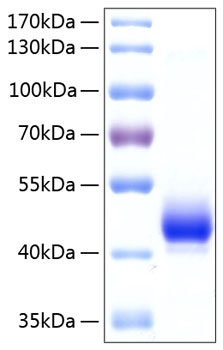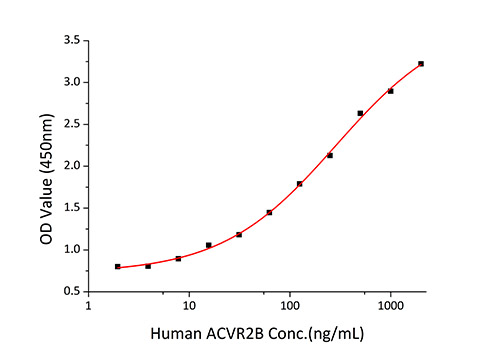Description
Recombinant Human ALK-4/ACVR1B Protein
The Recombinant Human ALK-4/ACVR1B Protein is a biologically active recombinant protein that plays a significant role in various cellular processes and signaling pathways in human biology. This protein is widely employed in immunological research, cell biology studies, protein-protein interaction analyses, and therapeutic development, providing researchers with a reliable tool for investigating ALK-4/ACVR1B function and its implications in health and disease.
This product (SKU: RPCB0245) is produced using HEK293 cells and features a C-hFc&his tag for convenient detection and purification. The protein exhibits a calculated molecular weight of 40.37 kDa with an observed molecular weight of 45-50 kDa under denaturing conditions, achieving ≥ 95 % as determined by SDS-PAGE.. Functional bioactivity has been validated through rigorous quality control assays, confirming its suitability for demanding research applications.
Key Features
| High Purity by Affinity Chromatography | |
| Mammalian & Bacterial Expression Systems | |
| High lot-to-lot consistency via strict QC |
| Product Name: | Recombinant Human ALK-4/ACVR1B Protein |
| SKU: | RPCB0245 |
| Size: | 50 μg , 100 μg |
| Reactivity: | Human |
| Synonyms: | ACTRIB, ACVRLK4, ALK4, SKR2, ACVR1B, ACVRLK4, ALK4, SKR2 |
| Tag: | C-hFc&his |
| Expression Host: | HEK293 cells |
| Calculated MW: | 40.37 kDa |
| Observed MW: | 45-50 kDa |
| Gene ID: | 91 |
| Protein Description: | High quality, high purity and low endotoxin recombinant Recombinant Human ALK-4/ACVR1B Protein (RPCB0245), tested reactivity in HEK293 cells and has been validated in SDS-PAGE.100% guaranteed. |
| Endotoxin: | < 0.1 EU/μg of the protein by LAL method. |
| Purity: | ≥ 95 % as determined by SDS-PAGE. |
| Formulation: | Lyophilized from a 0.22 μm filtered solution of PBS, pH 7.4.Contact us for customized product form or formulation. |
| Bio-Activity: | Measured by its binding ability in a functional ELISA. Immobilized Human ACVR1B at 0.5 μg/mL (100 μL/well) can bind Human ACVR2B with a linear range of 2.0-286.1 ng/mL. |
| Reconstitution: | Centrifuge the vial before opening. Reconstitute to a concentration of 0.1-0.5 mg/mL in sterile distilled water. Avoid vortex or vigorously pipetting the protein. For long term storage, it is recommended to add a carrier protein or stablizer (e.g. 0.1% BSA, 5% HSA, 10% FBS or 5% Trehalose), and aliquot the reconstituted protein solution to minimize free-thaw cycles. |
| Storage: | Store at -20℃.Store the lyophilized protein at -20℃ to -80 ℃ up to 1 year from the date of receipt. After reconstitution, the protein solution is stable at -20℃ for 3 months, at 2-8℃ for up to 1 week. |
ALK-4 (Activin Receptor-Like Kinase 4) or ACVR1B (Activin A Receptor, type 1B), belongs to the protein kinase superfamily, TKL Ser/Thr protein kinase family, and TGFB receptor subfamily. ALK-4/ACVR1B acts as a transducer of activin or activin like ligands signals. Activin binds to either ACVR2A or ACVR2B and then forms a complex with ACVR1B. The known type II activin receptors include ActRII and ActRIIB, while the main type I activin receptor in mammalian cells is ALK-4 (ActRIB). In the presence of activin, type II and type I receptors form complexes whereby the type II receptors activate ALK-4 through phosphorylation. The activated ALK-4, in turn, transduces signals downstream by phosphorylation of its effectors, such as Smads, to regulate gene expression and affect cellular phenotype. ALK-4/ACVR1B is an important regulator of vertebrate development, with roles in mesoderm induction, primitive streak formation, gastrulation, dorsoanterior patterning, and left-right axis determination.








